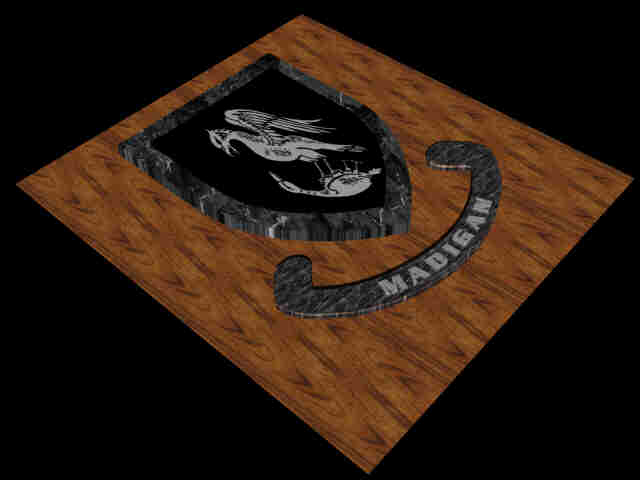The 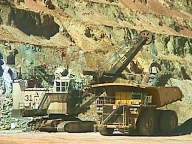 tires are pressured to
200 lbs, and are filled with nitrogen rather then air as nitrogen
will not heat up and thus will maintain constant pressure. We
were allowed to climb all over one of the monsters to get a feel
for what it was like to drive one. Following the trucks along we
soon arrived at the crusher. This breaks the rock down to smaller
size and dumps it onto a conveyor belt which carries it quite a
way to a building called the concentrator. High grade ore
arriving at the concentrator has about 40 to 60 lbs of copper per
ton. It is in the concentrator that the heaviest cost is
occurred. As we climbed the 182 steps that took
tires are pressured to
200 lbs, and are filled with nitrogen rather then air as nitrogen
will not heat up and thus will maintain constant pressure. We
were allowed to climb all over one of the monsters to get a feel
for what it was like to drive one. Following the trucks along we
soon arrived at the crusher. This breaks the rock down to smaller
size and dumps it onto a conveyor belt which carries it quite a
way to a building called the concentrator. High grade ore
arriving at the concentrator has about 40 to 60 lbs of copper per
ton. It is in the concentrator that the heaviest cost is
occurred. As we climbed the 182 steps that took 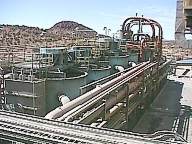 us along
the cat walks over the massive machinery, with our ears protected
with plugs and eye protectors in place, we were told that the
rock is dumped into tumblers which contain steel balls, very
large to start with and graduating down as the rock breaks up and
finally turns into a powder with a consistency smaller then
sugar. This is mixed with a reagent which causes a bubbly
mixture. Copper and the other minerals being lighter then much of
the conglomerate, floats to the surface and is skimmed off, the
remainder becomes more fill. There is a fast pass through a
sediment tank which allows more debris to settle out before the
muddy
us along
the cat walks over the massive machinery, with our ears protected
with plugs and eye protectors in place, we were told that the
rock is dumped into tumblers which contain steel balls, very
large to start with and graduating down as the rock breaks up and
finally turns into a powder with a consistency smaller then
sugar. This is mixed with a reagent which causes a bubbly
mixture. Copper and the other minerals being lighter then much of
the conglomerate, floats to the surface and is skimmed off, the
remainder becomes more fill. There is a fast pass through a
sediment tank which allows more debris to settle out before the
muddy 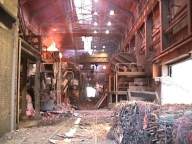 mixture
is sent on to the smelter. The mixture has been concentrated to
about 25 percent copper by this time. About 400 thousand tons of
ore are processed each day at a cost of some 4 megawatts per
machine, for which there were a half dozen or so, and over 20
million gallons of water per day. The water is recovered. The
electricity is not. Recent electrical shortages in California
have cut into the available power for the plant and threatens to
shut down the whole operation. At the smelter, the mess is dried
and then fed into the furnaces. Heated up to around 3000 degrees,
the copper liquefies and seeks it own specific gravity separating
mixture
is sent on to the smelter. The mixture has been concentrated to
about 25 percent copper by this time. About 400 thousand tons of
ore are processed each day at a cost of some 4 megawatts per
machine, for which there were a half dozen or so, and over 20
million gallons of water per day. The water is recovered. The
electricity is not. Recent electrical shortages in California
have cut into the available power for the plant and threatens to
shut down the whole operation. At the smelter, the mess is dried
and then fed into the furnaces. Heated up to around 3000 degrees,
the copper liquefies and seeks it own specific gravity separating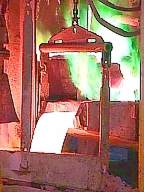 it from
all the other minerals present. It is poured off into ingots at
around 99.8 percent pure. The molds are actually solid copper
lined with ceramics and potash which works like greasing a pan.
Once heat is removed the copper solidifies quickly and within
minutes is popped out automatically and stacked for further
cooling. The whole process is controlled by one person in a glass
insulated enclosure who monitors the process and makes
adjustments where necessary. The one furnace we were at produced
an ingot about every 30 seconds. One of the side products of
reducing copper sulfate is sulfur, which is mixed with water to
form sulfuric acid, another product sold across the nation. Some
of the sulfuric acid makes it way back to the mine to be used as
part of the
it from
all the other minerals present. It is poured off into ingots at
around 99.8 percent pure. The molds are actually solid copper
lined with ceramics and potash which works like greasing a pan.
Once heat is removed the copper solidifies quickly and within
minutes is popped out automatically and stacked for further
cooling. The whole process is controlled by one person in a glass
insulated enclosure who monitors the process and makes
adjustments where necessary. The one furnace we were at produced
an ingot about every 30 seconds. One of the side products of
reducing copper sulfate is sulfur, which is mixed with water to
form sulfuric acid, another product sold across the nation. Some
of the sulfuric acid makes it way back to the mine to be used as
part of the 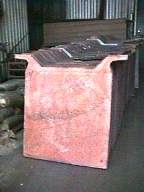 second copper extraction method. Low grade ore
is piled into large hills to which is added hundreds of small
vertical water lines. A very weak solution of sulfuric acid is
dripped out of the lines and allowed to seep through the hill.
The resulting liquid which is collected at the bottom is rich
with dissolved copper. This water is pumped into a large holding
tank. A 20 lb. piece of copper is lowered into the water after
which some 13000 volts is passed through the tank. The result is
a form of extrapolating as the copper jumps out of the water and
attaches itself to the copper plate. It is removed when around
320 lbs of 99.9 pure copper is attached. The solution is then
recycled. This goes on day after day, month after month. Once in
a while as the solution begins to deplete, the hills are turned
much as the ground would be with a plow. This exposes new
material and the process starts over again. This is the most
economical and environmentally prudent method of extracting
copper and, according to our guide, may someday be the only
approved method. It took over 4 hours to take the tour but the
time flew by. Fritz was delightful and the company allowing us to
get up close and personal to so much of the operations was
wonderful. For those who like to follow processes this is a great
way to spend the day.
second copper extraction method. Low grade ore
is piled into large hills to which is added hundreds of small
vertical water lines. A very weak solution of sulfuric acid is
dripped out of the lines and allowed to seep through the hill.
The resulting liquid which is collected at the bottom is rich
with dissolved copper. This water is pumped into a large holding
tank. A 20 lb. piece of copper is lowered into the water after
which some 13000 volts is passed through the tank. The result is
a form of extrapolating as the copper jumps out of the water and
attaches itself to the copper plate. It is removed when around
320 lbs of 99.9 pure copper is attached. The solution is then
recycled. This goes on day after day, month after month. Once in
a while as the solution begins to deplete, the hills are turned
much as the ground would be with a plow. This exposes new
material and the process starts over again. This is the most
economical and environmentally prudent method of extracting
copper and, according to our guide, may someday be the only
approved method. It took over 4 hours to take the tour but the
time flew by. Fritz was delightful and the company allowing us to
get up close and personal to so much of the operations was
wonderful. For those who like to follow processes this is a great
way to spend the day.
****THE END***

